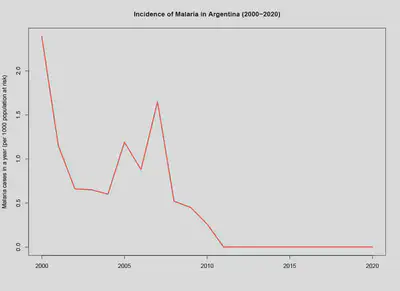2019

Overview
Argentina was WHO certified malaria-free in 2019 with the last indigenous case being reported in 2010. Anti-malaria efforts in Argentina began during the Global Eradication Program and continued thereafter in the 1960s with Argentina targeting the Northern provinces where malaria burden was highest. During this time, Argentina controlled mosquito breeding sites, sprayed houses with insecticides, and conducted active surveillance. In the 1990s, Argentina partnered with Bolivia to combat cross-border malaria and continued to work with the Bolivian government from 2000 to 2011 spraying more than 22,000 homes with insecticides and taking more than 25,000 blood samples to test for malaria. During this period, the number of malaria cases fell from 440 to zero in Argentina. Recently, an important undertaking was the integration of malaria surveillance into its national surveillance system for febrile illness allowing suspected cases to be quickly identified.
Malaria Incidence in Argentina (2000-2020)
| Year | Incidence of malaria (per 1,000 population at risk) |
|---|---|
| 2000 | 2.386725 |
| 2001 | 1.153570 |
| 2002 | 0.663454 |
| 2003 | 0.651127 |
| 2004 | 0.602726 |
| 2005 | 1.187881 |
| 2006 | 0.875545 |
| 2007 | 1.653051 |
| 2008 | 0.523952 |
| 2009 | 0.454516 |
| 2010 | 0.264087 |
| 2011 | 0 |
| 2012 | 0 |
| 2013 | 0 |
| 2014 | 0 |
| 2015 | 0 |
| 2016 | 0 |
| 2017 | 0 |
| 2018 | 0 |
| 2019 | 0 |
| 2020 | 0 |
References
Carter, E. D. (2012). Enemy in the blood: malaria, environment, and development in Argentina. University of Alabama Press.
World Health Organization. (2019). Algeria and Argentina certified as malaria-free. Wkly Epidemol Rec.
World Health Organization. (2019). Argentina’s journey to becoming malaria-free. Stories.